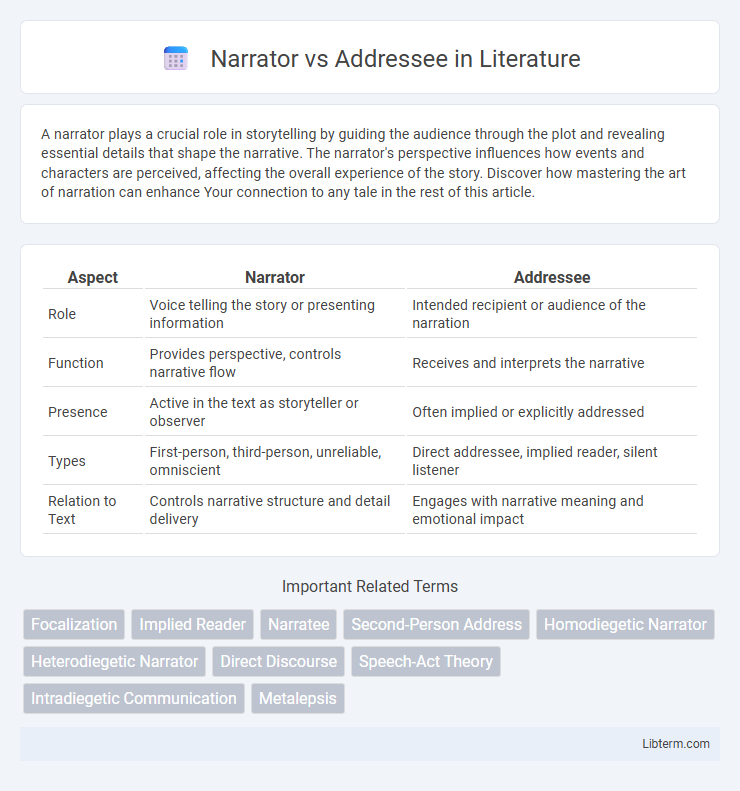A narrator plays a crucial role in storytelling by guiding the audience through the plot and revealing essential details that shape the narrative. The narrator's perspective influences how events and characters are perceived, affecting the overall experience of the story. Discover how mastering the art of narration can enhance Your connection to any tale in the rest of this article.
Table of Comparison
| Aspect | Narrator | Addressee |
|---|---|---|
| Role | Voice telling the story or presenting information | Intended recipient or audience of the narration |
| Function | Provides perspective, controls narrative flow | Receives and interprets the narrative |
| Presence | Active in the text as storyteller or observer | Often implied or explicitly addressed |
| Types | First-person, third-person, unreliable, omniscient | Direct addressee, implied reader, silent listener |
| Relation to Text | Controls narrative structure and detail delivery | Engages with narrative meaning and emotional impact |
Defining Narrator and Addressee
The narrator is the voice or character that conveys the story's events, shaping the reader's perception through perspective, tone, and reliability. The addressee refers to the intended audience or the character within the narrative whom the narrator directly addresses, often guiding interpretation and engagement. Defining the narrator and addressee clarifies narrative structure, communication dynamics, and the relationship between storyteller and listener.
Roles of the Narrator in Texts
The narrator serves as the primary voice conveying the story, shaping the reader's perception through perspective, tone, and reliability. This role includes controlling the flow of information, determining which events and characters are highlighted, and providing emotional or contextual insights. Effective narration establishes the framework within which the addressee - the intended audience or reader addressed by the narrator - interprets the narrative's meaning and thematic depth.
Types of Narrators in Literature
Types of narrators in literature include first-person, where the narrator is a character within the story using "I" to provide personal perspectives and subjective experiences. Third-person narrators can be omniscient, offering all-knowing insight into multiple characters' thoughts and events, or limited, focusing on a single character's viewpoint to create intimacy and bias. The addressee varies with narrative style, as in frame narratives where the narrator directly engages an audience or another character, influencing how information and emotional tone are conveyed.
Functions of the Addressee
The addressee functions as the recipient of the message, playing a crucial role in interpreting and responding to the narrator's discourse. They contribute to the dynamic interaction by providing feedback, influencing the narrative flow and meaning construction. Understanding the addressee's perspective is essential for analyzing how communication shapes the narrative context and purpose.
Narrator vs Addressee: Key Differences
The narrator is the voice that tells the story, providing perspective and guiding the audience through the narrative, while the addressee is the character or entity receiving the message within the text. Key differences include the narrator's role in shaping the narrative viewpoint, either first-person, third-person, or omniscient, contrasted with the addressee's function as the intended recipient of communication or storytelling within the plot. Understanding the distinction between narrator and addressee enhances the analysis of narrative techniques, character interactions, and the overall structure of literary works.
Narrative Perspective and Voice
Narrative perspective distinguishes the narrator's point of view from the addressee's position, shaping how the story is conveyed and received. The narrator's voice controls tone, style, and reliability, directing the audience's interpretation of events, while the addressee's identity influences narrative intimacy and engagement. Analyzing the interplay between narrator and addressee reveals layers of meaning and the narrative's communicative dynamics.
Direct vs Indirect Address in Storytelling
Narrator and addressee roles shape the storytelling experience through direct and indirect address techniques, influencing reader engagement and narrative perspective. Direct address involves the narrator speaking explicitly to the reader or a character, creating intimacy and immediacy, often using second-person pronouns like "you." Indirect address subtly conveys information through the narrator's voice or character thoughts, maintaining narrative distance while guiding interpretation and emotional response.
Impact on Reader Engagement
The dynamic between narrator and addressee significantly shapes reader engagement by creating an intimate or distant narrative voice that influences emotional investment. A first-person narrator addressing the reader directly fosters immediacy and personal connection, intensifying immersion and empathy. Conversely, an external narrator speaking to a characterized addressee can establish a formal or reflective tone, guiding readers through layered interpretations and enhancing critical engagement.
Examples in Classic and Modern Works
In classic literature, Jane Austen's "Pride and Prejudice" features a third-person omniscient narrator who provides insightful commentary on characters while addressing readers indirectly. Modern works like Haruki Murakami's "Norwegian Wood" employ a first-person narrator who directly engages the addressee, creating intimacy and immediacy. The contrast between these narrative approaches highlights varied techniques in shaping reader perception and emotional connection.
Importance in Narrative Structure
The narrator controls the delivery of the story, shaping the reader's perspective and guiding their interpretation through selective information and tone. The addressee, often implied, influences narrative layers by representing the intended audience within the story, creating a dialogue that deepens engagement and meaning. Their dynamic interaction establishes narrative reliability and affects how themes and events are perceived, making both elements crucial in narrative structure and reader experience.
Narrator Infographic

 libterm.com
libterm.com